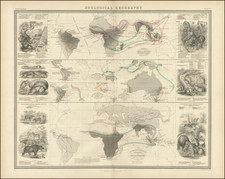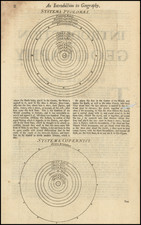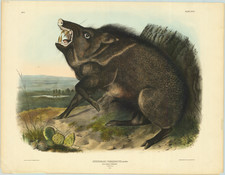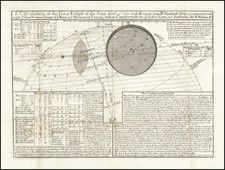Ursus-Ferox, Lewis & Clark. Grizzly Bear. Males, drawn from nature by J.W. Audubon, and lithographed by J.T.Bowen in Philadelphia in 1848, captures a striking representation of the male grizzly bear in its natural habitat. Set against a mountainous vista, the detailed lithograph showcases two grizzlies in differing postures—a serene resting pose juxtaposed with an alert stance bearing menacing teeth.
The early 19th century marked an era of exploration and documentation in America, and the expedition of Lewis & Clark was pivotal in charting the unexplored western territories of the continent. The grizzly bear, emblematic of the wilderness and the challenges encountered by the expedition, became a symbol of the rugged American West. This lithograph serves as an evocative reflection of this period, as well as a testament to the diverse fauna that once roamed more freely across the landscape.
John Woodhouse Audubon, an accomplished naturalist and artist, was renowned for his dedication to presenting wildlife in its most authentic form, often choosing to portray them in their natural environments. This dedication is evident in the lithograph, with the bears positioned in a meadow, complemented by a forest in the middleground—elements that evoke the richness of the bear's habitat. Such details underscore Audubon's commitment to both artistic excellence and scientific accuracy.
The stark contrast between the two bears—one peacefully at rest and the other exhibiting a raw display of power—offers viewers a nuanced understanding of the grizzly bear's nature. This duality, between tranquility and violence, echoes the broader tension of a rapidly expanding America grappling with its wild, untamed frontier.
The Viviparous Quadrupeds of North America: Imperial Folio Edition
John James Audubon, best known for his groundbreaking work The Birds of America, embarked on another ambitious project in the later years of his life: documenting the mammals of North America. This endeavor culminated in the creation of Viviparous Quadrupeds of North America, a substantial and influential work that delved into the diverse world of North American mammals with the same depth and artistry that had made his bird illustrations legendary.
John Woodhouse Audubon, born in 1812 in Henderson, Kentucky, was the second son of the renowned ornithologist and artist, John James Audubon. Despite often existing in the shadow of his eminent father, John Woodhouse carved out his own niche in the field of natural history illustration and was a significant contributor to the scientific explorations and recordings of 19th-century America.
Early Life and Education
John Woodhouse grew up immersed in the world of ornithology, naturalism, and art, given his father's groundbreaking work on The Birds of America. This upbringing, filled with travels and fieldwork, equipped him with the skills and passion to follow in his father's footsteps. As a boy, he accompanied his father on many expeditions, serving both as an assistant and absorbing the intricacies of nature study.
Professional Journey
By the 1830s, John Woodhouse began to play a pivotal role in his father's work. Notably, he contributed several illustrations to his father's monumental Birds of America. Recognizing his son's talent, John James Audubon sent John Woodhouse to Europe to receive formal training in the arts, fortifying his natural skills with the techniques of the time.
Upon his return, John Woodhouse took on an even more significant role in his father's endeavors. His contribution became especially vital during the creation of the octavo edition of Birds of America, where he assisted not just in producing illustrations but also in managing the logistics of the ambitious project.
Following the success of Birds of America, the Audubons set their sights on a new project, "The Viviparous Quadrupeds of North America". It was during this project that John Woodhouse's contributions became even more pronounced. With his father's health declining, he took on the responsibility of traveling the American frontier, sketching and observing the mammals of North America. His illustrations, particularly of mammals like the Silver Fox, highlighted his keen observation skills and his meticulous attention to detail.
Later Life and Legacy
After the passing of John James Audubon in 1851, John Woodhouse continued to promote and sell his father's works, ensuring their legacy in American natural history. However, the financial strains of the projects and the costs of maintaining the family estate, Minnie's Land, weighed heavily on him.
John Woodhouse Audubon passed away in 1862, but his contributions to American naturalism, particularly his work on The Viviparous Quadrupeds of North America, remain an invaluable testament to the scientific and artistic explorations of the 19th century. He may have begun his career in the shadow of his illustrious father, but through dedication and talent, he left a legacy in his own right.












![[ Janet Taylor -- Pioneer English Astronomer and Naval Navigation Expert ] Chart to Accompany R. Russel's Diagram of Great Circles / R. Russel's Diagram of Great Circles](https://storage.googleapis.com/raremaps/img/small/98801.jpg)

![(American Lithography) [Collection of Early American Lithographs, including the First Known American Lithograph of a Natural History Subject - by Charles Alexandre Lesueur; early lithographs by Abadie and other unnamed experimentalists; and unattributed student artwork, likely by pupils of Marie Duclos Fretageot's girl's school]](https://storage.googleapis.com/raremaps/img/small/90036.jpg)